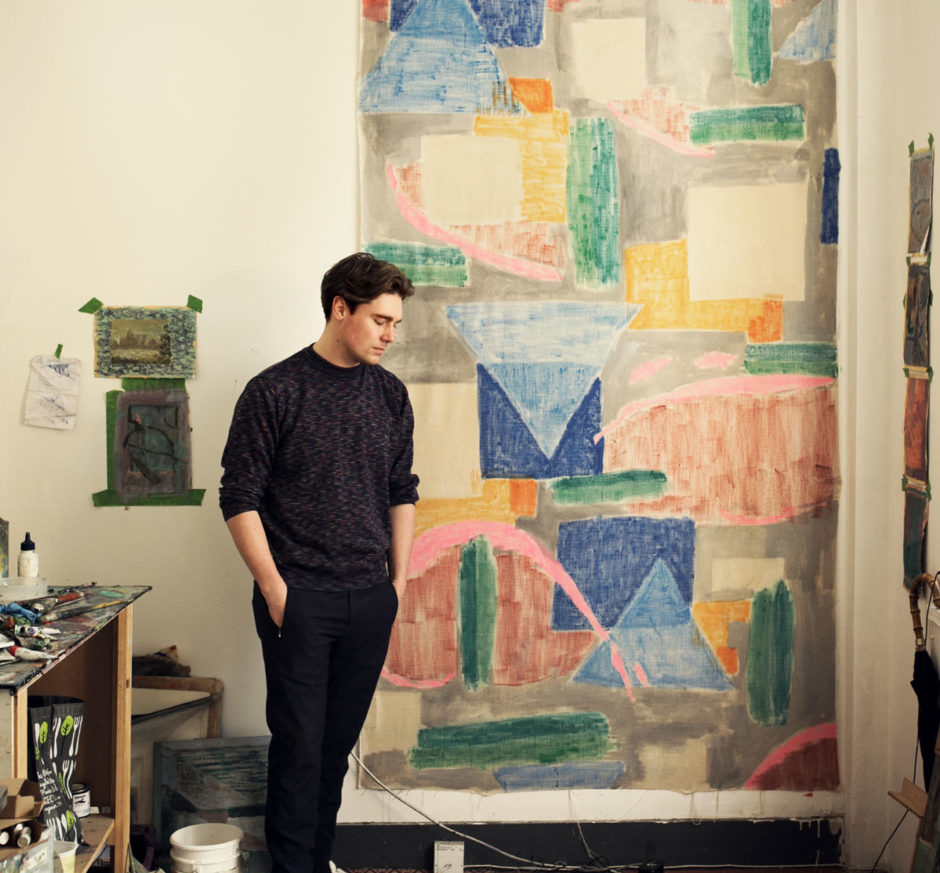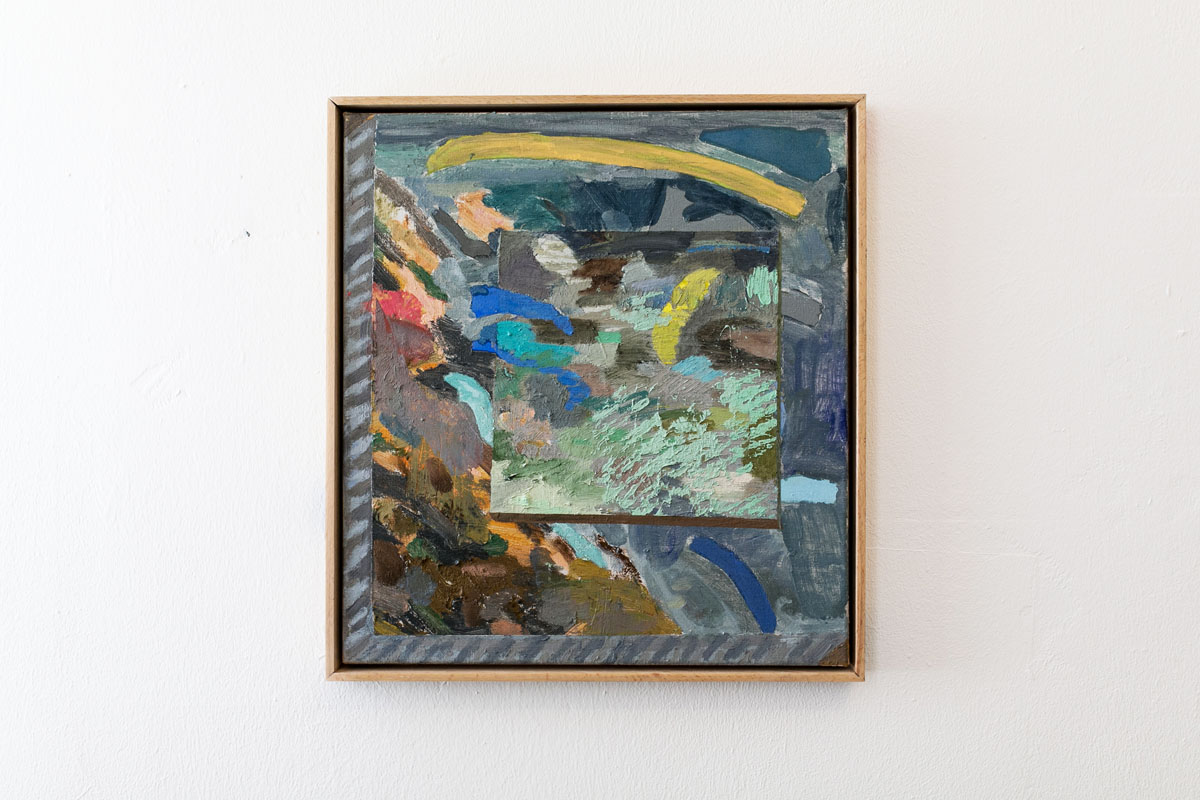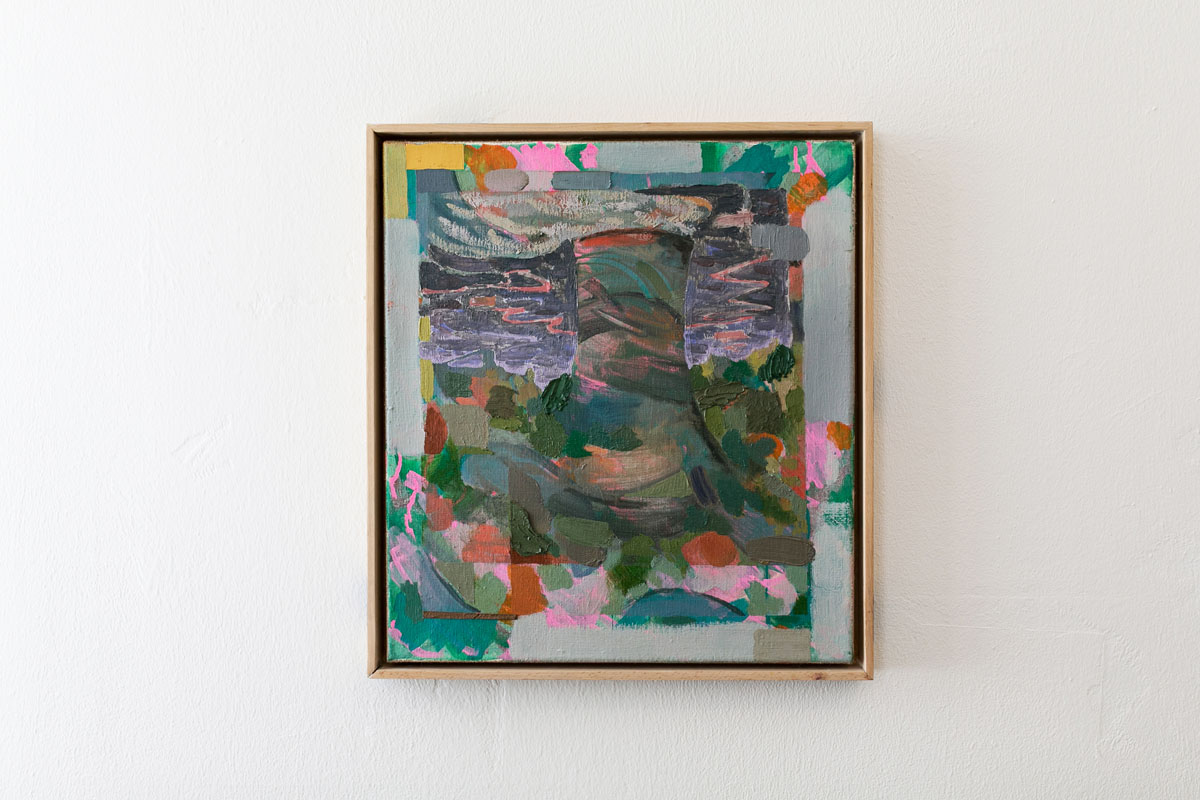ANTHONY BANKS, PAINTING AS GEOLOGY. After sharing a pot of tea in a pleasantly futuristic plein-air-and-yurt café on a bright and sunny spring afternoon in Limehouse, East London, regular Fused contributor Matt Price accompanied recent RCA graduate Anthony Banks to his nearby studio to find out how he is bringing twentieth-century British landscape painting into the twenty-first century.
As well as studying the latest trends in international contemporary painting, it is clear that Anthony Banks (b. 1988, Cheltenham) has been fully immersing himself in modernist painting, and, in particular, British painting of the twentieth century. Anyone who shares Banks’s passion – and it really can be a kind of love affair – will know that engaging with this particular series of chapters of painting’s history takes us on a journey all around the British Isles, from Wallis’s fishing villages of St Ives to Hitchens’s panoramic Sussex downs, from Sutherland’s opencast mines around Swansea to Nash’s Oxfordshire woodlands, from the Cumbrian landscapes of Winifred Nicholson to the rocky Ionian shoreline of Samuel Peploe, or Paul Henry’s windswept mountainside paths in County Kerry. It is, in part at least, a story of the geography of the British Isles, of how the landscape looks in different seasons, at different times of day, in different weather conditions, but also of life lived within it, how it is used and how it changes over time. It is equally a story of the changing languages of painting itself, and it is this rich and varied history that Banks is excavating through his own practice as he grapples with the concerns of painting today.
Banks takes us to the coast in his painting Frigate (Rigging), 2014-16, depicting a boat silhouetted against a sunset with its sails billowing in the sea breeze. The reflection of the boat’s hull in the water fragments into dark and light grey triangles, harmonising with the soft orange surface of the water under the warm setting sun. The brush marks are consciously raw and informal, with a simplicity reminiscent of naïve painting as much as more expressionist styles. Formally it might be considered a study of the triangle, and how to break out of it, the various acute angles periodically cut by curved lines hacked out in forthright black paint marks and at times smudging into the still wet colours they dissect. This almost timeless scene is cropped unusually, with a number of rectangular boxes outlining the image, as if it is a sketch on top of a pile of other sketches. On the right hand side, the palette changes as if to reveal a sliver of a landscape scene with grass and trees and a low horizon. These ‘frames within frames’ suggest that we are looking at a painting within a painting – perhaps there are numerous unseen paintings implied behind the image on the surface of the canvas. It is what curator Kristian Day describes as ‘geology’ within Banks’s works – a sense of different layers, of strata, both beneath and within the picture plane. That framing continues to be important to the artist even beyond the edge of the painting is underscored by the fact that Banks chooses to make his own frames, by hand, for many of his works. It’s not all that common for painters to make their own frames, and the fact that he always seems to make them from the same kind of wood, of the same colour, and to the same width, suggests that this continuity of framing is significant to him, signalling that it is he who finishes the work by framing it, and in this way it becomes part of the work itself.
The artist lingers a while longer on the seashore in his painting Coastlines, 2016-17, in which bold brush marks of simple yellows, orange and blue overlay a patchwork ground of duller greys, blues and browns. The overall effect is of an entirely abstract surface of marks, but the title gives us the confidence to interpret the image in terms of three-dimensional, figurative space, with a grey-green horizon, a snippet of turquoise sea, and a mud and clay-coloured hillside sloping down into the image from the left hand edge of the linen support. Curiously, a clearly defined square hovers over a considerable proportion of the centre right of the painting, with a diverging palette of mint and mushroom hues interspersed with the same muddy grey ground. It is as if we are looking at two different coastal scenes within the same painting, the one vignette crudely superimposed over the other larger scene, with just two blue streaks crossing over between the two. A stripy edge on the left and bottom suggests there might be a third image belying these two scenes, all presented in one of the artist’s handmade frames. Perhaps in part informed by the work of the recently deceased Howard Hodgkin, the different modes of viewing in Banks’s practice offer a critical, as well as optical, window into the landscapes on which he is reflecting.
Bringing us inland, though still preoccupied with water, land and sky, is the painting Mill, 2015-17, in which a hybrid windmill and watermill dominates a readable landscape scene. The sky is composed of irregularly shaped patches of different blues, the tree-lined horizon a thin dark grey fuzzy strip, the ground a mishmash of greys and greens, and a stream sketched out running alongside the base of the mill. The mill itself is multi-coloured – it is almost joyful in its lemon yellows, dusty peaches, assertive purples and mischievous hints of lime green. The sails of the mill are defined by simple outlines, and the waterwheel just hinted at with a fan of spokes and a shadowy curve underneath. There is an ‘all-over-ness’ to the surface of the painting, with passages of brush marks leaving a texture that could be felt if one were to run one’s fingers over the painting. Banks clearly revels in the pure physical pleasures of paint, its materiality combining with the colours, shapes and forms in a way that is enchanting for those who answer its call. Once again the main image is superimposed over larger rectangles, the first a brick-like configuration of browns and ochres, olives and paynes grey. Behind this is a surprisingly luminescent candy pink and soft grey swirling pattern, like floral wallpaper, as if we are viewing the painting pinned to a domestic wall. The combined palettes of the painting as a whole – which really shouldn’t work together – do strangely add up to more than the sum of their parts. Banks is, almost certainly, looking for innovative colour palettes, as well as unusual geometric formal devices, with which to engage with the genre of landscape today.
Banks’s exploration of colour in relation to the British landscape also takes a step forward in the work Portrait of a power station (Didcot), 2015-16. The view will be familiar to anyone who takes the Great Western mainline from London to Wales or the South West of England, as the now defunct Didcot Power Station looms large alongside the railway lines. Banks’s painting depicts a cooling tower still in action, a cloud of white steam floating off to the top left of the image. The landscape is made up of dappled marks – splodges of myriad greens interspersed with delightfully luminous pinks, rusts and reds. The pink is continued in the tower itself and the purple-grey sky, as if to outline the clouds beyond. While it is clearly a gloomy day, the artist captures a landscape alive with topography, bushes and trees. There is something unassumingly nostalgic and curiously British about this work, but it also has a contemporary, fresh and lively aspect to it – a combination that strongly suggests that Banks is well on his way to finding his own painterly language for engaging with not just the long and complex history of the depiction of the landscape by painters of generations past, but with both the British landscape and exciting international currents in painting today.
Matt Price
Anthony Banks’s exhibition ‘Geologies’ will be presented by Kristian Day at Tripp Gallery, 59 Amwell Street, Clerkenwell, London, from 19–27 May.











